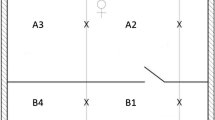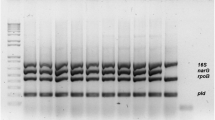Abstract
Histoplasmosis is considered the most important systemic mycosis in Mexico, and its diagnosis requires fast and reliable methodologies. The present study evaluated the usefulness of PCR using Hcp100 and 1281–1283(220) molecular markers in detecting Histoplasma capsulatum in occupational and recreational outbreaks. Seven clinical serum samples of infected individuals from three different histoplasmosis outbreaks were processed by enzyme-linked immunosorbent assay (ELISA) to titre anti-H. capsulatum antibodies and to extract DNA. Fourteen environmental samples were also processed for H. capsulatum isolation and DNA extraction. Both clinical and environmental DNA samples were analysed by PCR with Hcp100 and 1281–1283(220) markers. Antibodies to H. capsulatum were detected by ELISA in all serum samples using specific antigens, and in six of these samples, the PCR products of both molecular markers were amplified. Four environmental samples amplified one of the two markers, but only one sample amplified both markers and an isolate of H. capsulatum was cultured from this sample. All PCR products were sequenced, and the sequences for each marker were analysed using the Basic Local Alignment Search Tool (BLASTn), which revealed 95–98 and 98–100 % similarities with the reference sequences deposited in the GenBank for Hcp100 and 1281–1283(220), respectively. Both molecular markers proved to be useful in studying histoplasmosis outbreaks because they are matched for pathogen detection in either clinical or environmental samples.
Similar content being viewed by others
References
Altschul S, Madden T, Shäffer A, Zhang J, Zhang Z, Miller W, Lipman DJ (1997) Gapped BLAST and PSI-BLAST: a new generation of protein database search programs. Nucleic Acids Res 25:3389–3402
Anderson H, Honish L, Taylor G, Johnson M, Tovstiuk C, Fanning A, Tyrrell G, Rennie R, Jaipaul J, Sand C, Probert S (2006) Histoplasmosis cluster, golf course, Canada. Emerg Infect Dis 12:163–165
Bialek R, Feucht A, Aepinus C, Just-Nubling G, Robertson VJ, Knobloch J, Hohle R (2002) Evaluation of two nested PCR assays for detection of Histoplasma capsulatum DNA in human tissue. J Clin Microbiol 40:1644–1647
Bracca A, Tosello ME, Girardini JE, Amigot SL, Gomez C, Serra E (2003) Molecular detection of Histoplasma capsulatum var. capsulatum in human clinical samples. J Clin Microbiol 41:1753–1755
Buitrago MJ, Canteros CE, Frías De León G, González Á, Marques-Evangelista De Oliveira M, Muñoz CO, Ramírez JA, Toranzo AI, Zancopé-Oliveira R, Cuenca-Estrella M (2013) Comparison of PCR protocols for detecting Histoplasma capsulatum DNA through a multicenter study. Rev Iberoam Micol 30:256–260
Calanni LM, Pérez RA, Brasili S, Schmidt NG, Iovannitti CA, Zuiani MF, Negroni R, Finguelievich J, Canteros CE (2013) Brote de histoplasmosis en la provincia de Neuquén, Patagonia Argentina. Rev Iberoam Micol 30:193–199
Contreras C, Shibayama H, Gutiérrez P (1998) Aportaciones del Instituto Nacional de Diagnóstico y Referencia Epidemiológica a la histoplasmosis. Rev Inst Nal Enf Resp Mex 11:216–220
Corcho-Berdugo A, Muñoz-Hernández B, Palma-Cortés G, Ramírez-Hernández A, Martínez-Rivera M, Frías-de León M, Reyes-Montes M, Martínez-Valadez E, Manjarrez-Zavala M, Alfaro-Ramos L, Higuera-Iglesisa AL (2011) An unusual outbreak of histoplasmosis in residents of the state of Mexico. Gac Med Mex 147:377–384
Dantas KC, Freitas RS, Moreira AP, Silva MV, Benard G, Vasconcellos C, Criado PR (2013) The use of nested polymerase chain reaction (nested PCR) for the early diagnosis of Histoplasma capsulatum infection in serum and whole blood of HIV-positive patients. An Bras Dermatol 88:141–143
Frías De León MG, Arenas López G, Taylor ML, Acosta Altamirano G, Reyes-Montes MR (2012) Development of specific sequence-characterized amplified region markers for detecting Histoplasma capsulatum in clinical and environmental samples. J Clin Microbiol 50:673–679
Gago S, Esteban C, Valero C, Zaragoza O, Puig de la Bellacasa J, Buitrago MJ (2014) A multiplex real-time PCR assay for identification of Pneumocystis jirovecii, Histoplasma capsulatum, and Cryptococcus neoformans/Cryptococcus gattii in samples from AIDS patients with opportunistic pneumonia. J Clin Microbiol 52:1168–1176
González-González AE, Taylor ML, Curiel-Quesada E (2012) Aspectos relevantes del marcador molecular Hcp100 de Histoplasma capsulatum y su potencial uso terapéutico en la histoplasmosis. Rev Iberoam Micol 29:115–119
Guedes HL, Guimarães AJ, De Medeiros-Muniz M, Pizzini CV, Hamilton AJ, Peralta JM, Deepe GS, Zancopé-Oliveira RM (2003) PCR assay for identification of Histoplasma capsulatum based on the nucleotide sequence of the M antigen. J Clin Microbiol 41:535–539
Haynes K, Westerneng T, Fell J, Moens W (1995) Rapid detection and identification of pathogenic fungi by polymerase chain reaction amplification of large subunit ribosomal DNA. J Med Vet Mycol 3:319–325
Ley Federal del trabajo (2012) Diario Oficial de la Federación. Distrito Federal, México, 13 de noviembre
Martagon-Villamil J, Shrestha N, Sholtis M, Isada CM, Hall GS, Bryne T, Lodge BA, Reller LB, Procop GW (2003) Identification of Histoplasma capsulatum from culture extracts by real-time PCR. J Clin Microbiol 41:1295–1298
Millon L, Herbrecht R, Grenouillet F, Morio F, Alanio A, Letscher-Bru V, Cassaing S, Chouaki T, Kauffmann-Lacroix C, Poirier P, Toubas D, Augereau O, Rocchi S, Garcia-Hermoso D, Bretagne S, Group FMS (2015) Early diagnosis and monitoring of mucormycosis by detection of circulating DNA in serum: retrospective analysis of 44 cases collected through the French Surveillance Network of Invasive Fungal Infections (RESSIF). Clin Microbiol Infect. doi:10.1016/j.cmi.2015.12.006
Muñoz C, Gómez BL, Tobón A, Arango K, Restrepo A, Correa MM, Muskus C, Cano LE, González A (2010a) Validation and clinical application of a molecular method for identification of Histoplasma capsulatum in human specimens in Colombia, South America. Clin Vaccine Immunol 17:62–67
Muñoz B, Martínez MA, Palma G, Ramírez A, Frías MG, Reyes MR, Taylor ML, Higuera AL, Corcho A, Manjarrez ME (2010b) Molecular characterization of Histoplasma capsulatum isolated from an outbreak in treasure hunters. BMC Infect Dis 10:264–269
Tang YW, Li H, Durkin MM, Sefers SE, Meng S, Connolly PA, Stratton CW, Wheat LJ (2006) Urine polymerase chain reaction is not as sensitive as urine antigen for the diagnosis of disseminated histoplasmosis. Diagn Microbiol Infect Dis 53:46–51
Taylor ML, Granados J, Toriello C (1996) Biological and sociocultural approaches of histoplasmosis, in the state of Guerrero, Mexico. Mycoses 39:375–379
Taylor ML, Chávez-Tapia CB, Vargas-Yáñez R, Rodríguez-Arellanes G, Peña-Sandoval GR, Toriello C, Pérez A, Reyes-Montes MR (1999) Environmental conditions favoring bat infection with Histoplasma capsulatum in Mexican shelters. Am J Trop Med Hyg 61:914–919
Taylor ML, Chávez-Tapia CB, Rojas-Martínez A, Reyes-Montes MR, Bobadilla del Valle M, Zúñiga G (2005a) Geographical distribution of genetic polymorphism of the pathogen Histoplasma capsulatum isolated from infected bats, captured in a central zone of Mexico. FEMS Immunol Med Microbiol 45:451–458
Taylor ML, Ruíz-Palacios GM, Reyes-Montes MR, Rodríguez-Arellanes G, Carreto-Binaghi LE, Duarte-Escalante E, Hernández-Ramírez A, Suárez-Alvarez RO, Roldán-Aragón YA, Romero-Martínez R, Sahaza-Cardona JH, Sifuentes-Osornio J, Soto-Ramírez LE, Peña-Sandoval GR (2005b) Identification of the infectious source of an unusual outbreak of histoplasmosis, in a hotel in Acapulco, state of Guerrero, Mexico. FEMS Immunol Med Microbiol 45:435–441
Ueda Y, Sano A, Tamura M, Inomata T, Kamei K, Yokoyama K, Kishi F, Ito J, Mikami Y, Miyaji M, Nishimura K (2003) Diagnosis of histoplasmosis by detection of the internal transcribed spacer region of fungal rRNA gene from a paraffin-embedded skin sample from a dog in Japan. Vet Microbiol 94:219–224
Vaca-Marín MA, Martínez-Rivera MA, Flores-Estrada JJ (1998) Histoplasmosis en México, aspectos históricos y epidemiológicos. Rev Inst Nal Enf Resp Mex 11:208–215
Velasco-Castrejón O (1998) La histoplasmosis pulmonar primaria en México. Rev Inst Nal Enf Resp Mex 11:221–225
Voller A, Bidwell DE, Bartlett A (1979) The enzyme linked immunosorbent assay (ELISA). A guide with abstracts of microplate applications. Dynatech Europe Laboratories, Inc, London
Author information
Authors and Affiliations
Corresponding author
Ethics declarations
Animal manipulations were in accordance with the suggestions of the Ethics Committee of the School of Medicine, UNAM, and following the recommendations of the Animal Care and Use Committee of the UNAM and the Mexican Official Guide (NOM 062-ZOO-1999).
Conflict of interest
The authors declare that they have no competing interests.
Additional information
Maria Lucia Taylor and María del Rocío Reyes-Montes were equally involved in the design and coordination of this study, as well as in the writing of this manuscript.
Rights and permissions
About this article
Cite this article
Frías-De-León, M.G., Ramírez-Bárcenas, J.A., Rodríguez-Arellanes, G. et al. Usefulness of molecular markers in the diagnosis of occupational and recreational histoplasmosis outbreaks. Folia Microbiol 62, 111–116 (2017). https://doi.org/10.1007/s12223-016-0477-4
Received:
Accepted:
Published:
Issue Date:
DOI: https://doi.org/10.1007/s12223-016-0477-4




